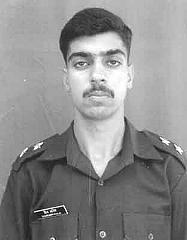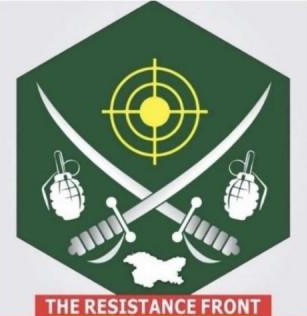Related Research Articles

Since the Partition of British India in 1947 and subsequent creation of the dominions of India and Pakistan, the two countries have been involved in a number of wars, conflicts, and military standoffs. A long-running dispute over Kashmir and cross-border terrorism have been the predominant cause of conflict between the two states, with the exception of the Indo-Pakistani War of 1971, which occurred as a direct result of hostilities stemming from the Bangladesh Liberation War in erstwhile East Pakistan.

The Kargil War, also known as the Kargil conflict, was fought between India and Pakistan from May to July 1999 in the Kargil district of Jammu and Kashmir and elsewhere along the Line of Control (LoC). In India, the conflict is also referred to as Operation Vijay, which was the codename of the Indian military operation in the region. The Indian Air Force acted jointly with the Indian Army to flush out the Pakistan Army and paramilitary troops from vacated Indian positions along the LoC, in what was designated as Operation Safed Sagar.

The insurgency in Jammu and Kashmir, also known as the Kashmir insurgency, is an ongoing separatist militant insurgency against the Indian administration in Jammu and Kashmir, a territory constituting the southwestern portion of the larger geographical region of Kashmir, which has been the subject of a territorial dispute between India and Pakistan since 1947.

The Kashmir conflict is a territorial conflict over the Kashmir region, primarily between India and Pakistan, and also between China and India in the northeastern portion of the region. The conflict started after the partition of India in 1947 as both India and Pakistan claimed the entirety of the former princely state of Jammu and Kashmir. It is a dispute over the region that escalated into three wars between India and Pakistan and several other armed skirmishes. India controls approximately 55% of the land area of the region that includes Jammu, the Kashmir Valley, most of Ladakh, the Siachen Glacier, and 70% of its population; Pakistan controls approximately 30% of the land area that includes Azad Kashmir and Gilgit-Baltistan; and China controls the remaining 15% of the land area that includes the Aksai Chin region, the mostly uninhabited Trans-Karakoram Tract, and part of the Demchok sector.

Para (Special Forces), also known as Para Commandos or Para (SF) Commandos, is a group of special forces battalions of the Parachute Regiment in the Indian Army. These units specialize in various roles including counter-terrorism, hostage rescue, unconventional warfare, special reconnaissance, counter-insurgency and direct action.

Saurabh Kalia was an officer of the Indian Army who was killed during the Kargil War while being held as a prisoner of war by the Pakistan Army. He and five soldiers in his patrol group were captured by Pakistani troops following a gunfight at the Line of Control and tortured prior to their execution; the Government of Pakistan has rejected all allegations of Indian military personnel being tortured while in Pakistani custody.

Kurukshetra is a 2008 Indian Malayalam language war film written and directed by Major Ravi. It is a prequel to the 2006 film Keerthi Chakra and the second installment in the Major Mahadevan film series, with Mohanlal reprising his role as Colonel Mahadevan The film is based on the Kargil conflict of 1999 between India and Pakistan. The political situation of the conflict is portrayed from an Indian perspective.
Ilyas Kashmiri, also referred to as Maulana Ilyas Kashmiri, Mufti Ilyas Kashmiri and Muhammad Ilyas Kashmiri, was a Pakistani ex-Special Forces Islamist guerrilla insurgent who fought against Indian troops in Kashmir.
The 2011 India–Pakistan border skirmish was a series of incidents which took place during the months of July and August 2011 across the Line of Control in Kupwara District and Neelam Valley. Both countries gave different accounts of the incident, each accusing the other of initiating the hostilities.
Human rights abuses in Jammu and Kashmir range from mass killings, enforced disappearances, torture, rape and sexual abuse to political repression and suppression of freedom of speech. The Indian Army, Central Reserve Police Force (CRPF), and Border Security Personnel (BSF) have been accused of committing severe human rights abuses against Kashmiri civilians. According to Seema Kazi, militant groups have also been held responsible for similar crimes, but the vast majority of abuses have been perpetrated by the armed forces of the Indian government.

The 2013 India–Pakistan border incidents was a series of armed skirmishes along the Line of Control (LoC) in the disputed Kashmir area. Starting from the mid-January 2013, they have been described as the "worst bout of fighting in the region in nearly 10 years". It began on 6 January 2013, when according to Pakistani reports Indian forces attacked a Pakistani border post, killing one soldier. Indian authorities claimed the incident as a retaliation against preceding Pakistani ceasefire violations, but denied having crossed the demarcation line. In a second skirmish on 8 January, Indian authorities said that Pakistani forces crossed the LoC, killing two Indian soldiers. The incident sparked outrage in India and harsh reactions by the Indian army and government over the news that the body of one of the soldiers had been beheaded. Pakistan denied these reports. On 15 January, a third skirmish reportedly led to the death of another Pakistani soldier.

Al-Qaeda in the Indian Subcontinent usually abbreviated as AQIS, is a branch of the Islamist militant organization Al-Qaeda which aims to fight the governments of Pakistan, Afghanistan, India, Myanmar and Bangladesh in order to establish an Islamic state and seeks to establish an Islamic caliphate in Indian Subcontinent.

The 2014–2015 India–Pakistan border skirmishes were a series of armed clashes and exchanges of gunfire between the Indian Border Security Force and the Pakistan Rangers: the paramilitary gendarmerie forces of both nations, responsible for patrolling the India-Pakistan border) along the Line of Control (LoC) in the disputed Kashmir region and the borders of the Punjab. Tensions began in mid-July 2014, with both countries' military officials and media reports giving different accounts of the incidents and accusing each other of initiating the hostilities. The incident sparked outrage in both countries and harsh reactions by the Indian and Pakistani militaries and the Indian and Pakistani governments.
Zakir Rashid Bhat was a Kashmiri separatist who became the commander of Hizbul Mujahideen after the killing of Burhan Wani and Sabzar Bhat, who were the former commanders of the same outfit. He later became the chief of Ansar Ghazwat-ul-Hind.

The 2016 Uri attack was carried out on 18 September, 2016 by four Jaish-e-Mohammed militants from Pakistan against an Indian Army brigade headquarters near the town of Uri in the Indian Jammu and Kashmir. 19 Indian soldiers were killed in the attack, and 19–30 others were injured. It was reported by the BBC as having been "the deadliest attack on security forces in Kashmir in two decades".

The 2016–2018 India–Pakistan border skirmishes were a series of armed clashes between India and Pakistan, mostly consisting of heavy exchanges of gunfire between Indian and Pakistani forces across the de facto border, known as the Line of Control (LoC), between the two states in the disputed region of Kashmir. The skirmishes began after India claimed to have conducted surgical strikes against militant launch pads within the Pakistani-administered territory of Azad Jammu and Kashmir on 29 September 2016.

Stone pelting in Kashmir refers to stone throwing by Kashmiris on the Indian forces and Jammu and Kashmir Police deployed for crowd control in Jammu and Kashmir to support the separatists, insurgents, or terrorists. In the local language, it is termed as "Kanni Jung", which means fighting with stones and the stone pelters are called as Sangbaaz or Pathraw Player. However, in the recent past the number of stone pelting has dropped significantly.

On 29 September 2016, teams of Indian Army commandos crossed the Line of Control into Pakistani-administered Kashmir to attack targets up to a kilometer within territory held by Pakistan. The raid occurred ten days after four militants had attacked an Indian army outpost at Uri on 18th September 2016 in the Indian state of Jammu and Kashmir, and killed 19 soldiers. Estimates of casualties from India's cross-border attack varied widely, with figures of 12 to 70 being reported. The Pakistani government eventually acknowledged the deaths of two soldiers and injuries to nine, while one Indian soldier was captured.

The Resistance Front or TRF is a separatist militant organization involved in the ongoing insurgency in Jammu and Kashmir. The organization has positioned itself as a secular organization fighting against the Indian government for Kashmiri freedom, in contrast to past Kashmiri insurgents which have been Islamist. The Indian government has accused the TRF of being an offshoot of Pakistan-based Lashkar-e-Taiba, a claim that TRF has denied. TRF operates primarily in the Kashmir region, with a main base in Srinagar.
References
- 1 2 3 4 5 6 7 Raghavan, Ranjani (23 September 2009). "Dead sepoy's village doesn't know his killer is killed in Pakistan". The Indian Express . Retrieved 30 September 2016.
- 1 2 3 Pubby, Manu (22 September 2009). "24-yr-old sepoy was beheaded in 2000 LoC raid". The Indian Express . Retrieved 30 September 2016.
- ↑ Manu Pubby (22 September 2009). "24-yr-old sepoy was beheaded in 2000 LoC raid - Indian Express". Indian Express. Retrieved 13 October 2016.
- 1 2 3 Joseph, Josy (5 June 2011). "Col faced CoI after Ilyas Kashmiri attack". The Times of India . Retrieved 30 September 2016.
- ↑ Joseph, Josy (10 January 2013). "Pak cross-LoC raid: Brutality similar to 2000 strike by Ilyas Kashmiri". The Times of India . Retrieved 30 September 2016.
- ↑ Manu Pubby (22 September 2009). "24-yr-old sepoy was beheaded in 2000 LoC raid - Indian Express". Indian Express. Retrieved 12 October 2016.
- ↑ Sørensen, Kaare (9 June 2016). The Mind of a Terrorist: The Strange Case of David Headley. UK: Penguin. ISBN 978-9386057310 . Retrieved 6 October 2016.
- ↑ Pandit, Rajat; Joseph, Josy (9 January 2013). "Pak troops kill two jawans, behead, mutilate one of them". The Times of India . Retrieved 1 October 2016.
- ↑ Unnithan, Sandeep (11 January 2013). "Pakistani Barbarism At The Border". India Today . Retrieved 6 October 2016.
- ↑ K, M; Danfes. "Pak Brutality, It's In Blood". The Day After. Archived from the original on 9 October 2016. Retrieved 6 October 2016.
- 1 2 Swami, Praveen (11 June 2011). "Pakistan's Kashmiri problem". The Hindu . Retrieved 30 September 2016.
- ↑ Khan, Zaigham (7 June 2011). "Death of a quintessential Jihadi". Dawn . Retrieved 4 October 2016.
- ↑ Arora, Kamna (11 January 2013). "Ilyas Kashmiri still alive inside Pakistani troops". Zee News. Retrieved 1 October 2016.
- ↑ Bhattacharya, Tathagata (4 June 2011). "Who is Illyas Kashmiri?". News18.com. Retrieved 6 October 2016.
- ↑ "Beheadings and Vengeance: A Cycle of Killing on a Border in Kashmir". New York Times. 15 May 2017.
- 1 2 Josephy, Josy (1 October 2013). "Back in the day, cross-LoC hit and run was a given". The Hindu . Retrieved 3 October 2016.
- ↑ "Slain Indian soldiers might have fallen into a death trap set up by Pakistani BATs". Live Mint. 1 May 2017.
- ↑ "Fallen Indian soldiers might have walked into death trap". Economic Times. 12 July 2018.
- ↑ "How Pakistan crossed the LoC and beheaded 2 soldiers". Rediff News. 1 May 2017.